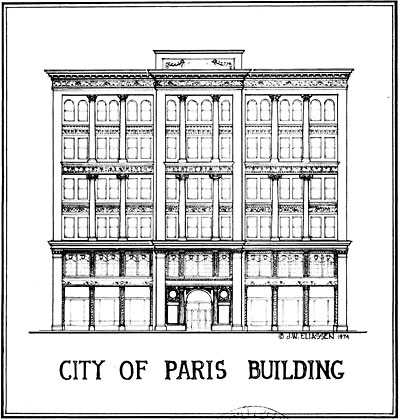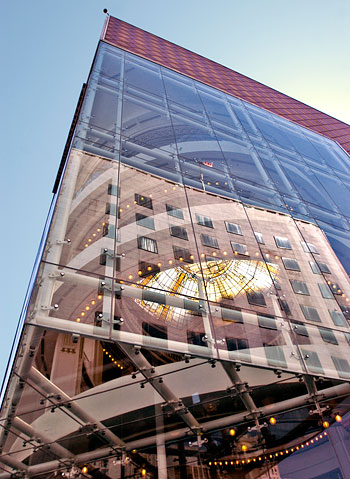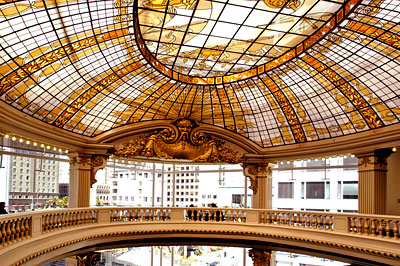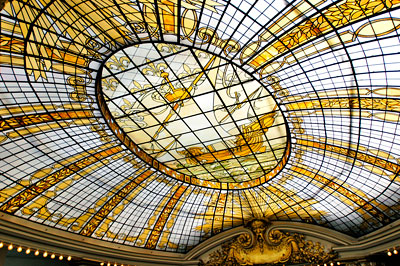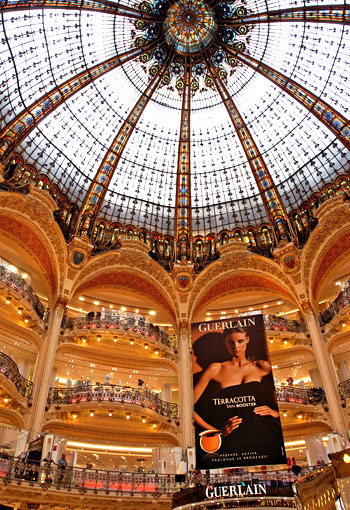National Register of Historic Places in San Francisco
City of Paris Building
Intersection of Geary and Stockton Streets
Built 1896
Rebuilt 1909
Demolished 1981
City of Paris, was one of several San Francisco buildings nominated for historical recognition in a failed attempt to save them from the wreckers ball. Two other buildings were the International Hotel and Hoffman Grill.

The City of Paris building, demolished by Neiman Marcus, was one of the few buildings in downtown San Francisco to survive the 1906 Earthquake and Fire.
City of Paris was founded by Felix Verdier in May 1850 when he arrived in San Francisco on the ship, Ville de Paris, loaded with silks, laces, fine wines, champagne, and Cognac. San Franciscans quickly surrounded the ship with rowboats and purchased all the goods, many with bags of gold dust.
Verdier returned to France, restocked the ship, and returned to San Francisco in 1851 to open a small waterfront store at 152 Kearny Street. (Kearny Street was still on the waterfront in 1851.) Verdier's store, named City of Paris, borrowed the Latin motto from the coat of arms of the city of Paris: Fluctuat nec mergitur (It is tossed by the waves but does not sink).
In 1896, City of Paris moved into a Beaux-Arts building designed by architect Clinton Day at the corner of Geary and Stockton across from Union Square. The building survived the 1906 Earthquake and Fire, but because of internal damage, its interior was demolished leaving its two street facades intact.
The Verdier family commissioned John Balkewell, Arthur Brown and Louis Bourgeois, graduates of the Ecole des Beaux Arts in Paris, to consult on remodeling. This team became San Francisco's greatest Neoclassicists, designing San Francisco City Hall (San Francisco Landmark 21), the War Memorial Opera House (San Francisco Landmark 84), and most major buildings in the Civic Center (NRHP Listing #78000757).
The team made few modifications to the exterior but designed the great elliptical rotunda. The design is subdued, yet elegant, and occasionally even playful, a quality lacking from their later public commissions. The skylight incorporates the store's nautical origin and motto.
The City of Paris rotunda represents the vigor, optimism, and bold elegance with which San Francisco rebuilt itself following 1906. At least four generations of San Franciscans hold the sight of a sixty-foot Christmas tree under the gigantic lead glass dome as one of their best memories. The motto set in the uppermost glass panel of the rotunda remains the undeniable sentiment of San Francisco itself: Fluctuat nec mergitur .
Adapted from the NRHP nomination and from Wikipedia

The following excerpt from an article by Paul Goldberger in the 15 November 1983 edition of the New York Times typifies the reception given to the Neiman Marcus building on Union Square.
Neiman-Marcus replaces the old City of Paris department store, a building that, thanks to its exquisite oval rotunda topped by a stained-glass dome, was as beloved a building as any in downtown San Francisco. Not surprisingly, San Franciscans were not pleased when Neiman-Marcus announced in 1974 that it had bought the old City of Paris building, which it intended to demolish for a brand-new department store; even Neiman-Marcus's agreement to preserve the rotunda within the framework of Mr. Johnson's and Mr. Burgee's new structure, a checkerboard box of reddish granite, did not mollify the opposition.But the plan went ahead, and now that the building is done and the store is open, it is easy to see that the preservation-minded folk of this town knew wherefrom they spoke. For the Neiman-Marcus building, even with the gracious rotunda preserved, is one of this city's most conspicuous architectural mistakes. It is an awkward intrusion into San Francisco, a building that struggles to reflect a certain spirit and ends up, instead, capturing that spirit under glass and nearly suffocating it.
Neiman-Marcus is a glittery, showy and altogether modern building; with its checkerboard facade and square windows punched out at asymmetrical points, it comes off as a disquieting mix of the sleek and the decorated. Out of the corner of this box has been scooped a slice into which the City of Paris rotunda has been fitted; that, in turn, is covered by a new glass-and-metal skin, so that the entire rotunda is now visible from Union Square, like a little glass tower at the corner of the store.
The rotunda is thus surrounded by hard, sleek modern materials, and the subtle dialogue between old and new that exists in the best projects of this sort is nowhere present. Instead, the old seems trapped in the new, put on display in the front window as if it were a four-story-high jewel that Neiman-Marcus had to sell, rather than a piece of architecture. The glass and metal skin around the rotunda has not even the anonymity that glass sometimes possesses; it is an intruding presence, as is the heavy corner of the building that extends out over the rotunda, giving us a sense of mass weighing down on the glass corner.

Neiman Marcus has done quite well here.
In 2009, the Union Square store - with 251,000 square feet - was the largest Neiman Marcus.
Beverly Hills, by comparison had 185,000 square feet and Boca Raton had 136,000.
